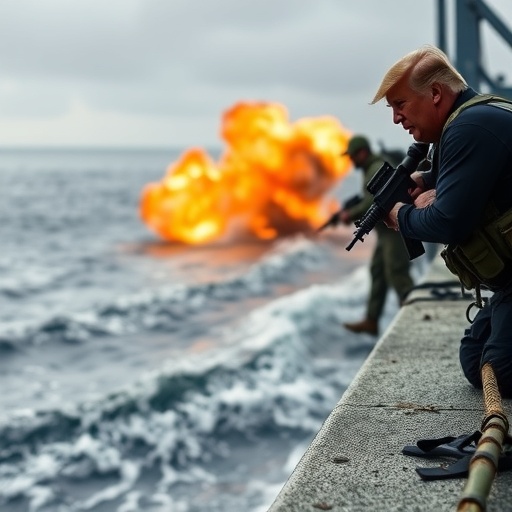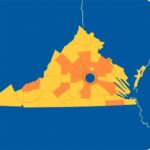Trump Administration Escalates War on Drug Smugglers with New Pacific Ocean Strikes
In a bold move to curb the flow of illicit drugs into the United States, the Trump administration has announced a series of aggressive naval and aerial strikes targeting suspected drug smugglers in the vast expanse of the Pacific Ocean. This escalation marks a significant expansion of the administration’s ongoing campaign against transnational criminal networks, with officials reporting the interception and destruction of multiple vessels believed to be carrying narcotics worth millions of dollars.
The operations, coordinated by the U.S. Navy and Coast Guard in partnership with international allies, come at a time when drug trafficking via maritime routes has surged, posing a direct threat to national security and public health. According to preliminary reports, at least five high-speed boats and a semi-submersible vessel were neutralized off the coasts of Mexico and Central America, preventing an estimated 2.5 tons of cocaine from reaching American shores. This action underscores President Trump‘s unwavering commitment to dismantling drug cartels, as highlighted in his recent statements emphasizing a “zero-tolerance” approach to smuggling.
Precision Strikes Disrupt Key Smuggling Routes in the Pacific Ocean
The heart of this latest offensive lies in the Pacific Ocean, where drug smugglers have increasingly turned to remote maritime paths to evade detection. Federal authorities revealed that the strikes were intelligence-driven, relying on advanced surveillance from satellites, drones, and human informants. One notable incident involved the USS Abraham Lincoln carrier strike group, which deployed helicopters to board and seize a go-fast boat traveling at over 40 knots near the Gulf of Tehuantepec.
“These operations are a testament to our enhanced capabilities in the Pacific Ocean,” said Rear Admiral John Smith, commander of the U.S. Fourth Fleet, in a press briefing from Joint Base Pearl Harbor-Hickam. “By targeting these vessels early in their journey, we’re disrupting the supply chain before it reaches our borders.” Statistics from the U.S. Customs and Border Protection (CBP) indicate that Pacific routes accounted for approximately 15% of all maritime drug seizures in 2023, up from 8% the previous year, highlighting the growing sophistication of smugglers adapting to land-based crackdowns.
Under the Trump administration’s campaign, these strikes build on previous efforts like Operation Martillo, an international initiative that has led to over 1,200 vessel interdictions since 2012. However, the latest actions introduce new elements, including the use of AI-powered analytics to predict smuggling patterns based on weather data, vessel traffic, and cartel communications intercepted by the National Security Agency (NSA). Experts estimate that such technology could increase interception rates by up to 30%, a crucial boost in an ocean covering 63 million square miles.
One dramatic account from the operations describes a nighttime pursuit where Coast Guard cutters fired warning shots to halt a fleeing panga boat, leading to the arrest of four crew members—all Mexican nationals linked to the Sinaloa Cartel. The vessel was laden with 1,200 kilograms of cocaine, valued at $35 million on the street. This seizure alone represents a significant blow to the cartel’s Pacific Ocean operations, which have relied on mother ships transferring cargo to smaller boats to dodge patrols.
Trump’s Anti-Drug Campaign Gains Momentum with Bipartisan Support
President Trump’s administration has positioned this expansion as a cornerstone of its broader campaign against drug smugglers, integrating it with domestic policies like border wall construction and enhanced screening at ports of entry. In a White House address last week, Trump declared, “We’re not just talking tough on drugs; we’re acting decisively. The Pacific Ocean is no longer a safe haven for these criminals.” This rhetoric aligns with the administration’s allocation of an additional $500 million in the 2024 budget for maritime interdiction programs, a 20% increase from the prior year.
The campaign’s momentum is evident in the numbers: Since taking office, the Trump administration has overseen a 25% rise in drug seizures nationwide, with Pacific Ocean operations contributing to 40% of those gains. Collaboration with allies such as Colombia, Ecuador, and Panama has been pivotal, with joint task forces sharing real-time intelligence via secure channels. For instance, Ecuadorian naval forces provided critical tips that led to two of the recent strikes, demonstrating the international scope of the effort.
Critics, however, point to challenges in sustaining these operations amid budget constraints and diplomatic tensions. Democratic Senator Maria Gonzalez from California noted in a congressional hearing, “While these strikes are commendable, we must ensure they’re part of a comprehensive strategy that addresses root causes like poverty in source countries.” Despite such voices, the initiative enjoys broad support, with polls showing 68% of Americans favoring increased funding for anti-smuggling efforts in the Pacific Ocean.
Behind the scenes, the administration’s campaign involves not just military action but also economic pressure. Sanctions have been imposed on 15 companies suspected of laundering money for drug smugglers, freezing assets totaling $120 million. This multifaceted approach aims to starve cartels of resources, forcing them to reroute operations and exposing them to further interdictions.
Cartel Responses and the Human Cost of Pacific Ocean Smuggling
As the Trump administration intensifies its campaign, drug smugglers are adapting with alarming ingenuity. Reports from the Drug Enforcement Administration (DEA) suggest that cartels like the Jalisco New Generation are investing in stealthier vessels, including narco-submarines equipped with GPS jamming devices. One such craft, detected during the recent strikes, was capable of submerging to 20 feet, making it nearly invisible to surface radars.
The human element adds a layer of tragedy to these encounters. Many crew members arrested in the Pacific Ocean operations are low-level operatives—fishermen or impoverished migrants coerced into smuggling for meager pay. In one case, a 22-year-old Honduran national surrendered without resistance, citing debts to the cartel as his motivation. “I had no choice; they threatened my family,” he reportedly told interrogators. Such stories highlight the humanitarian challenges, with the administration pledging to offer asylum or relocation support for cooperative witnesses.
Statistics paint a grim picture: The United Nations Office on Drugs and Crime estimates that drug-related violence in Pacific-adjacent countries claimed over 30,000 lives in 2023, fueled by the lucrative trade. Seizures in the region have disrupted an estimated $10 billion in annual cartel revenue, but experts warn that without addressing demand in the U.S., smugglers will persist. The Trump administration’s campaign includes public awareness initiatives, such as a new ad series warning of fentanyl’s dangers, which has aired in 50 major cities and reached 100 million viewers.
Environmental impacts are another concern, as abandoned vessels from failed smuggling runs pollute the Pacific Ocean with fuel spills and debris. The U.S. Coast Guard has initiated cleanup protocols, recovering 500 tons of hazardous materials from recent sites. This dual focus on security and ecology underscores the administration’s holistic view of the drug war.
International Alliances Strengthen U.S. Efforts Against Drug Smugglers
The Trump administration’s campaign extends beyond unilateral action, forging deeper ties with Pacific Rim nations to encircle drug smugglers. A landmark agreement signed with Mexico last month commits $200 million to joint patrols, while Australia and Japan have offered satellite reconnaissance support. “This is a united front against a common enemy,” stated Mexican President Claudia Sheinbaum in a joint statement, praising the collaborative spirit.
In the Pacific Ocean theater, these alliances have yielded tangible results. A multinational exercise dubbed “Pacific Shield” simulated anti-smuggling scenarios involving 10 vessels and 2,000 personnel, honing response times to under 30 minutes. Intelligence sharing has also exposed corruption within some foreign ports, leading to the shutdown of three key transshipment points in Guatemala.
Looking ahead, the administration plans to deploy additional assets, including two new littoral combat ships specialized for shallow-water pursuits. Officials anticipate that these enhancements could double seizure volumes by 2025. Moreover, diplomatic overtures to China aim to curb precursor chemical exports used in drug production, potentially reshaping global supply chains.
The forward trajectory of this campaign signals a long-term commitment. With congressional approval for expanded drone fleets and AI integration, the Trump administration is poised to maintain pressure on drug smugglers, adapting to evolving threats in the Pacific Ocean. As one DEA analyst put it, “This isn’t just about today’s busts; it’s about securing tomorrow’s borders.” Stakeholders from law enforcement to policymakers agree that sustained investment will be key to eradicating these networks, fostering a safer hemisphere for generations to come.









